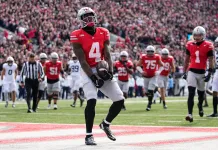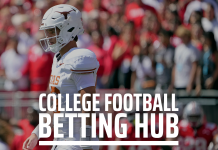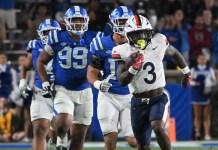Projecting College Football Improvement/Decline:
Each year I like to combine my College Football Stability data with key stats and other tidbits from the prior season to predict potential improvement or decline. I did something similar for pro football a couple of months back.
College sports present some different challenges from the pros in that there is typically much greater turnover in rosters and coaching staffs. Evaluating these changes properly is one of the most crucial aspects of season-long success for bettors. You must consider personnel losses, coaching changes, lost or gained momentum and many other factors. NIL and the expanded transfer portal have made this even more difficult.
I try to quantify the signs of potential improvement or decline based on year-to-year transitional situations. All the elements in this piece were factors in my College Football Stability Scores. After identifying some key criteria for each of the factors, I went back and looked at teams from recent seasons fitting certain criteria to determine their average improvement or decline.
Admittedly, the number of teams qualifying for these systems has wavered tremendously over the last few seasons, skewing the statistics. However, I view the methodology as most important and don’t feel that the fundamental logic has changed based on the unusual circumstances of the last few years, starting with the COVID-19 pandemic.
As you will see, there are some obvious reasons why teams have gotten significantly better or worse from one season to another. Hopefully this will give you a foundation to start a successful handicapping run this season, both in terms of game-by-game handicapping and in attacking season win total props. I will be doing the latter in the coming weeks.
This data dates to the 2013 season, or the last 11 seasons, unless noted.
Next week, in Part 2 of this series, I will address some STATISTICAL transition systems that 2024 teams fit into.
Analyzing Number of Returning Starters
The number of returning starters on a team can provide great clues. Here are some of the systems I have discovered and track annually:
• Over the last 10 years, 118 teams have had at least six fewer returning starters than the previous season, and only 30 of them have improved that season. The average drop-off of those that didn’t improve was a winning percentage decline of 19% and ATS drop-off of about 6.0%.
Potential decline teams for 2024: AIR FORCE, AKRON, ARMY, DUKE, FLORIDA ATLANTIC, FLORIDA STATE, JACKSONVILLE STATE, MICHIGAN, MIDDLE TENNESSEE STATE, OHIO, OREGON STATE, SOUTH ALABAMA, SAN JOSE STATE, TEMPLE, TOLEDO, TROY, UTEP, WASHINGTON
Note that there were just nine teams on this system for 2023, meaning there are twice as many this year.
• Alternatively, of the 127 teams over the last 11 years that brought back at least six starters more than the prior season, only 49 got worse, although half of them came in 2021, when most teams had a greater percentage of their starters back. The average improvement of the group that didn’t drop off was a winning percentage bump of 21% and ATS rise of 7.7%.
Potential improve teams for 2024: ARKANSAS, BAYLOR, CINCINNATI, COLORADO, INDIANA, KENT STATE, LOUISIANA, LIBERTY, OKLAHOMA STATE, STANFORD, TCU, UTAH STATE, VIRGINIA TECH, WESTERN MICHIGAN
• The total number of starters returning has also proved to be a great predicting factor, as there have been 185 teams in the last 11 seasons that returned 10 or fewer starters, and only 41 have improved their winning percentage. The average drops for the opposite group were 21% in win percentage and 6% in ATS percentage. The combined ATS mark of these teams was 753-952 ATS, or 44.2%, a clear play-against group.
Potential decline teams for 2024: AIR FORCE, AKRON, ARIZONA STATE, BALL STATE, BUFFALO, DUKE, EASTERN MICHIGAN, FLORIDA STATE, GEORGIA STATE, HOUSTON, JACKSONVILLE STATE, LOUISIANA-MONROE, LOUISIANA TECH, MARSHALL, MICHIGAN, MIDDLE TENNESSEE STATE, MISSISSIPPI STATE, NEW MEXICO, NEW MEXICO STATE, NORTH TEXAS, OHIO, OLD DOMINION, OREGON STATE, SOUTH ALABAMA, SAN DIEGO STATE, SAN JOSE STATE, SOUTHERN MISS, TEMPLE, TOLEDO, TROY, UTEP, WASHINGTON, WASHINGTON STATE
With 33 teams on this year’s list, the total is about twice the usual annual amount. We’ll see what impact this has on the overall results of this system. Theoretically, we would expect only about seven of these teams to improve.
• The opposite group of the previous system features teams that return 16 or more total offensive and defensive starters. That group has included 346 teams over the last 11 seasons, and only 111 (32%) have recorded a worse won-lost record. The average improvement of the teams that didn’t drop off was a bump of 18% outright and 9% against the spread.
Potential improve teams for 2024: ARKANSAS, ARKANSAS STATE, AUBURN, BAYLOR, BOISE STATE, BOSTON COLLEGE, COLORADO, INDIANA, IOWA, IOWA STATE, JAMES MADISON, KENNESAW STATE, KENTUCKY, MEMPHIS, MIAMI, NORTHERN ILLINOIS, NEBRASKA, OKLAHOMA STATE, OLE MISS, OREGON, SOUTH FLORIDA, STANFORD, SYRACUSE, TCU, TEXAS, TEXAS A&M, VIRGINIA, VIRGINIA TECH, WESTERN MICHIGAN
We’ve seen some stabilizing of the number of teams qualifying for this angle lately, as 31 did a year ago, two more than this year’s 29.
What does a returning starting quarterback mean?
From a generic sense, returning a starting quarterback has meant an increase of about 2.0% in winning percentage. Since 2013, of the 891 teams that brought back a starting quarterback, 432 improved, 86 posted the same record and 373 declined. However, oddsmakers seem to place an emphasis on this fact, as there is an average decline in ATS winning percentage (~1%). Still, these teams have covered about 50.4% of their games, so in the end, it is still advantageous to back teams with returning QBs. Before last season, 74 teams had their starting quarterback returning, and 34 improved, six held par, while 32 wound up with lesser records than in 2022. For 2024, 54 starting QBs return.
On the other hand, teams with a brand-new quarterback see their records drop by 3.4% on average while covering just 49% of point spreads. The outright winning percentage figure has been falling in recent years, thanks in large part to experienced transfers coming into new programs. Let’s dig deeper.
• Since 2013, 82 teams have brought in a new starting quarterback and four or fewer total offensive starters. Of these, only 20 teams improved, and the average decline of those that didn’t was a 22% decrease in winning percentage and a 4% ATS drop-off. The combined ATS% of that group was just 44.7%.
Potential decline teams for 2024: AIR FORCE, AKRON, BUFFALO, EASTERN MICHIGAN, FLORIDA ATLANTIC, FLORIDA STATE, GEORGIA STATE, KANSAS STATE, LOUISIANA-MONROE, MARYLAND, MICHIGAN, MISSISSIPPI STATE, NEW MEXICO, NORTH TEXAS, OHIO, OREGON STATE, SOUTH ALABAMA, SAN JOSE STATE, SOUTHERN MISS, TOLEDO, TROY, WASHINGTON
• The group that’s the opposite of the one above is one you’ll want to keep track of in 2024. Teams with a returning starting quarterback as well as at least nine other offensive starters have shown great improvement, about 8% on winning percentage and 1% ATS. Collectively, of these 82 teams, only 26 declined, and the group was 52.6% against the spread over the last 11 seasons. That is a profit-making record with no other factors considered. Something to watch for 2024 with the teams below:
Potential improve teams for 2024: ARKANSAS STATE, IOWA, IOWA STATE, MEMPHIS, OKLAHOMA STATE, OLE MISS, SOUTH FLORIDA, STANFORD, VIRGINIA TECH
• There is a dangerous assumption made about teams bringing back a starting quarterback from an explosive unit to an otherwise relatively new offensive group. In fact, over the last 11 seasons, 33 teams scored 32+ PPG the prior season and returned the starting QB but only four or fewer other starters. Of those, 27 have DECLINED by 3.2 wins per season on average and by 7.4 PPG. The combined ATS winning percentage of the 33 teams was only 45% (180-220 ATS).
Potential decline team for 2024: APPALACHIAN STATE
• Teams returning a starting quarterback for at least a second straight season as starter show nice improvement usually, typically by about 2% winning and 0.6 PPG. When you add the same head coach/offensive coordinator to the recipe along with at least eight other offensive returning starters, the improvement jumps by 9% in won-lost record per season and 52.4% ATS combined.
Potential improve teams for 2024: MEMPHIS, MISSOURI, OLE MISS, SOUTH FLORIDA, TEXAS TECH, VIRGINIA TECH
• One of the biggest improvements in wins from one season to the next comes when nine or more offensive starters, including the quarterback, return from a team that won 33% or less of its games against the spread in the previous season. The average win increase is 14% SU and 25.2% ATS. These teams score 5.5 PPG more as well and combined to go 52.8% ATS.
Potential improve teams for 2024: Kent State
• On the opposite side of that mix comes the teams coming off of seasons in which they won 66.7% or more of their games against the spread and have six or fewer offensive starters returning, plus are breaking in a new quarterback. The 33 teams that have fit that bill over the last 11 seasons have dropped by an average of 18.4% outright, 19.6% ATS and 5.8 PPG offensively. (The five teams that added a new head coach plummeted by 5.8 wins per season, and there are two qualifiers for this in 2024 noted with an asterisk below) We have an unusually high number of teams meeting the criteria for this fall:
Potential decline teams for 2024: COASTAL CAROLINA, JACKSONVILLE STATE, KANSAS STATE, NEW MEXICO STATE *, NOTRE DAME, RICE, SAN JOSE STATE *, UNLV
What impact does a new coaching staff have?
New head coaches or coordinators on either side of the ball can change a team’s fortunes dramatically. It’s not always negative, however, as much of it depends on the combination of coaches and player experience. Take a look at these recent results.
• Entire new coaching staffs (HC, OC, DC) combined with a new starting quarterback and 11 or fewer total starters returning is a very unstable situation and certainly not a winning recipe in college football. This group of 37 teams over the last 11 seasons has seen its winning percentage drop by 9.3% on average, and the teams have collectively gone just 37.4% SU and 42% ATS. Thirteen programs qualify on this angle for 2024.
Potential decline teams for 2024: BUFFALO, DUKE, GEORGIA STATE, LOUISIANA-MONROE, MICHIGAN, MISSISSIPPI STATE, NEW MEXICO, NEW MEXICO STATE, OREGON STATE, SOUTH ALABAMA, SAN DIEGO STATE, TROY, WASHINGTON
• Clearly there is major room for improvement when a team wins 25% or fewer games in the prior season, but some of the biggest improvement is realized when these teams bring back their starting quarterback AND hire a new head coach AND coordinators. Over the last 11 seasons, the average winning percentage increases of the 34 teams that have done this has been 19.6% SU and 15.9% ATS. In fact, in 2022, Temple improved by 50% ATS from year to year. Last season, USF went from 1-11 SU and 5-7 ATS to 7-6 SU and ATS.
Potential improve teams for 2024: NEVADA, UTEP
• Offensive coordinator changes when combined with little experience returning is also a trouble sign. Over the last 11 seasons, 77 teams have hired new offensive coordinators the same season they had five or fewer offensive starters returning and a new quarterback. Only 19 teams improved. The 77 teams have declined by 11.3% in winning percentage and 1.3% ATS. They collectively have gone just 44.4% ATS, making them a strong play-against group. The average scoring output dropped about 4.0 PPG.
Potential decline teams for 2024: AKRON, BUFFALO, CONNECTICUT, DUKE, EASTERN MICHIGAN, GEORGIA SOUTHERN, GEORGIA STATE, KANSAS STATE, LOUISIANA-MONROE, MARSHALL, MICHIGAN, MICHIGAN STATE, MISSISSIPPI STATE, NEW MEXICO, NEW MEXICO STATE, NOTRE DAME, OREGON STATE, SOUTH ALABAMA, SAN JOSE STATE, SOUTHERN MISS, TROY, WASHINGTON
• Defensive coordinator changes combined with inexperience is also a recipe for trouble. Of the 142 teams that have changed D-coordinators in a season and brought back five or fewer defensive starters, only 44 have improved their won-lost percentage. The average decline was 8.2% in winning percentage and 2.9% ATS. These teams have covered only 45.9% of their point spreads and allowed 2.9 PPG more.
Potential decline teams for 2024: BALL STATE, DUKE, GEORGIA TECH, HOUSTON, JACKSONVILLE STATE, LOUISIANA-MONROE, LOUISIANA TECH, MICHIGAN, MIDDLE TENNESSEE STATE, MISSISSIPPI STATE, MISSOURI, NEW MEXICO STATE, OHIO, OREGON STATE, SOUTH ALABAMA, SAM HOUSTON STATE, SAN DIEGO STATE, TEXAS STATE, UNIV, TROY, UCLA, UTEP, WASHINGTON






